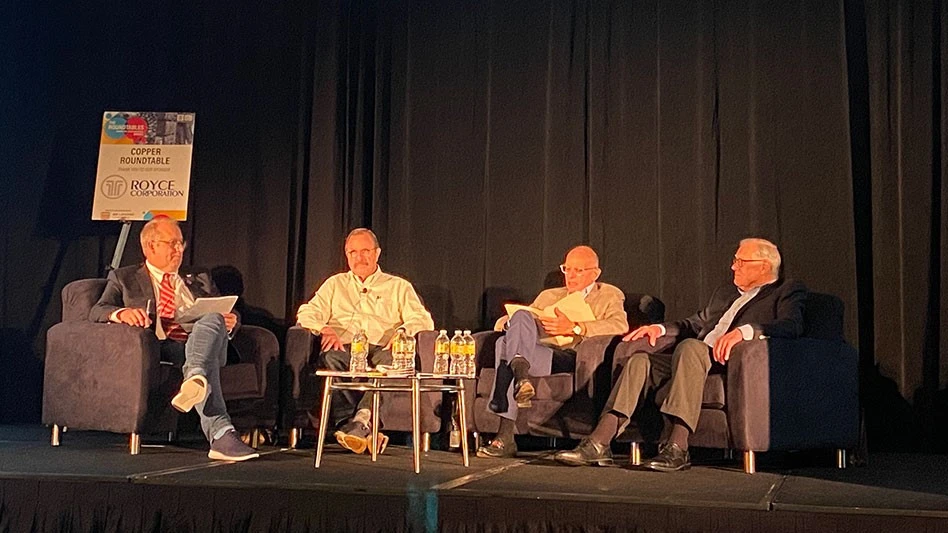
Photo by DeAnne Toto
The U.S. is seeing a resurgence of the copper recycling industry as the global copper market faces a deficit position and mining projects have hit roadblocks, said John Gross, publisher of "The Copper Journal." Gross was among the panelists speaking during the Copper Roundtable, Sept. 15, as part of the Institute of Scrap Recycling Industries (ISRI) Commodity Roundtables in Chicago.
Gross said the meeting was timely given that the U.S. copper industry is in the midst of the most important fundamental change that has happened during the past 25 years, if not longer, as investments are being made in secondary copper production. “The U.S. copper industry has reached pivotal point, and recyclers are in the middle of it.”
Among the companies announcing projects are Ames Copper Group, Aurubis, Igneo and Wieland.
“These investments in copper are just the beginning,” Gross said, adding that other companies will jump on board.
Despite being the world’s largest economy, refined copper production and consumption have been declining in the U.S. “That's a sad situation,” Gross said. The U.S. consumes about 1.95 million metric tons of copper cathode per year, which is down from about 3.2 million metric tons in 2000. “If we look at consumption, inclusive of scrap, the number has changed dramatically,” Gross said. “So, you're up to 2.86 million [metric] tons when we put both sides of the equation together. So, scrap represents in the neighborhood of 30 percent of total copper consumption in the U.S.”
He added that the U.S. cannot have a green energy transition without copper. “We cannot rely on imports of copper” to make this transition; secondary copper production will expand in the U.S., Gross said.
Tim Strelitz, owner and president of California Metal-X, a copper-scrap-based alloy manufacturer in Los Angeles, said that when he founded his company in 1979, the U.S. was home to five secondary smelters.
However, environmental compliance issues contributed to the closure of these facilities. Lower grades of copper scrap then ended up being exported to other countries, primarily China, and returned to the U.S. in the form of air conditioners and electrical appliances, Gross said.
In terms of copper production and consumption, Strelitz said, “China might have reached its apex.” He added, “It will be interesting to see what happens with respect to the United States and events here. Our opinion is, finally, we're seeing a resurgence of the copper industry in North America.”
Strelitz congratulated SDI La Farga, which began melting and refining copper scrap in Indiana in 2012, for recognizing the future of copper production and consumption. “We're going to come back to the United States.”
Given the deficit position copper is in, Gross said, “the price should be a heck of a lot higher than it is.” He added, “So why isn't it? That's an open-ended question. And I don't have Logically the answer.”
Strelitz added, “Knowing that copper is very tight, the price ought to be closer to $4.50, while we keep getting down to $3.40 and $3.30. And the lesson learned from that is don't play the game—sell what you buy and keep it moving.”
Edward Meir, president of Commodity Research Group, Darien, Connecticut, said, “I’ve never seen a situation where we have no metals inventories, and yet their prices are coming down.” He added that “markets don't seem to care about that” for two reasons: a belief that there are off-exchange stocks and nervousness on the demand side.
Regarding off-exchange inventories, Meir said, he didn’t believe that was the case. “I don't think there is that much metal that's floating around, especially in this day and age.”
The rising dollar also is putting pressure on commodity prices, Meir said. “As the dollar has gone up, commodity prices have been under pressure, and they're falling—especially in the last few weeks, we've seen a very close correlation,” he said. Meir added that the Fed is “playing a very dangerous game because they keep ratcheting the rates higher just when inflation could be leveling up and leveling off. And I think there is a danger they really could do a lot of damage to the economy as they go on this binge of raising rates because Wall Street is demanding it.”
The ISRI Commodity Roundtables were Sept. 14-16 in Chicago.
Latest from Recycling Today
- BMW Group, Encory launch 'direct recycling’ of batteries
- Loom Carbon, RTI International partner to scale textile recycling technology
- Goodwill Industries of West Michigan, American Glass Mosaics partner to divert glass from landfill
- CARI forms federal advocacy partnership
- Monthly packaging papers shipments down in November
- STEEL Act aims to enhance trade enforcement to prevent dumping of steel in the US
- San Francisco schools introduce compostable lunch trays
- Aduro graduates from Shell GameChanger program





